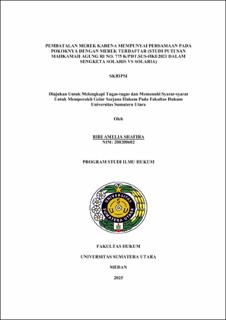| dc.contributor.advisor | Runtung | |
| dc.contributor.advisor | Chairi, Zulfi | |
| dc.contributor.author | Shafira, Riri Amelia | |
| dc.date.accessioned | 2025-03-19T04:05:34Z | |
| dc.date.available | 2025-03-19T04:05:34Z | |
| dc.date.issued | 2025 | |
| dc.identifier.uri | https://repositori.usu.ac.id/handle/123456789/102264 | |
| dc.description.abstract | A brand is a tool to distinguish goods and services produced by a company. The importance of a brand in terms of influencing business development in a good or service can be seen from the desire of the community who are buyers or consumers in using goods or services that have a well-known brand. With this regulation, business actors can compete fairly and healthily and are unlikely to harm the community in their efforts. However, in addition, it is also colored by anti-competitive actions which hinder competition so that competition in the business is not desired. Then it is also colored by cheating which has a pattern almost the same as the previous one where those who hold a monopoly position will cheat as desired.
The formulation of the problem is; 1) What is the Scope of Similarities in Principle in the Trademark Legal System in Indonesia?, 2) What Legal Remedies Can Be Taken by Registered Trademark Owners Who Are Harmed by the Use of a Trademark That Has Similarities in Principle?, 3) What is the Court's Attitude in Deciding on a Dispute of a Lawsuit by a Registered Trademark Owner Who Has Similarities in Principle with Someone Else's Trademark? The type of research used in this study is normative juridical assisted by the nature of the research, namely analytical descriptive. Conclusion: The element of similarity in principle in a trademark cancellation lawsuit that meets the elements of brand formation must be considered as a whole as a complete unit without breaking down its parts. The process of resolving the use of trademark disputes in Indonesia where trademark disputes can be resolved through lawsuits in court or alternative dispute resolution such as arbitration. The trademark dispute lawsuit process is the absolute authority of the commercial court.
The cancellation of a trademark related to trademark similarity in the Solaris Vs Solaria Decision based on the explanation of Article 21 paragraph (1) of Law Number 20 of 2016 concerning Trademarks and Geographical Indications "similarity in principle" is a similarity caused by the presence of a dominant element between one Trademark and another Trademark so that it gives the impression of similarity, such as shape, placement method, writing method or combination of elements, or similarity of pronunciation. Suggestion, namely that the current trademark registration regulations are indeed quite good, but Violations of the principle of good faith in trademark registration must be able to provide a deterrent effect on parties who try to violate the principle of good faith. A database or brand base should be created that can automatically detect similarities in brands so that it can save time in analyzing registered brands | en_US |
| dc.language.iso | id | en_US |
| dc.publisher | Universitas Sumatera Utara | en_US |
| dc.subject | trademark cancellation | en_US |
| dc.subject | similarities in essence | en_US |
| dc.title | Pembatalan Merek karena Mempunyai Persamaan pada Pokoknya dengan Merek Terdaftar (Studi Putusan Mahkamah Agung RI No. 775 K/Pdt.Sus-HKI/2021 dalam Sengketa Solaris Vs Solaria) | en_US |
| dc.title.alternative | Trademark Cancellation Due to Similarities with Registered Trademarks (Study of The Supreme Court Decision Number 775 k/PDT.Sus-HKI/2021 in The Solaris VS Solaria Dispute) | en_US |
| dc.type | Thesis | en_US |
| dc.identifier.nim | NIM200200602 | |
| dc.identifier.nidn | NIDN0010105622 | |
| dc.identifier.nidn | NIDN0001087102 | |
| dc.identifier.kodeprodi | KODEPRODI74201#Ilmu Hukum | |
| dc.description.pages | 112 Pages | en_US |
| dc.description.type | Skripsi Sarjana | en_US |
| dc.subject.sdgs | SDGs 16. Peace, Justice And Strong Institutions | en_US |


